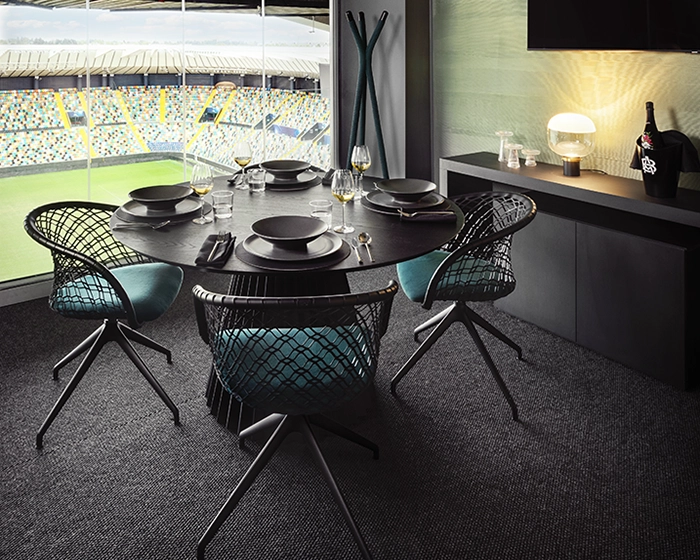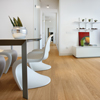
This wood type is widely used for the production of parquet, due to its characteristics. Its natural colour goes from brown to red and even light yellow and these colours do not change during seasoning. The colour variations start with the sawing, but the most evident chromatic changes appear due to oxidation caused by sunlight, that makes the silica, naturally present in the wood, to stand out. Oxidation processes, however, whose effects are very important in doussie, make the veins to consolidate and to conform and it does not alter the resistance and the hardness of the flooring. Due to oxidation, doussie’s colour becomes darker. For this reason, samples are always different from the final flooring. This wood type can look different or have a different colour, according to the particular climatic and mineralogic features of the place where the tree grows, or even the place where it is cut or the orientation of the stem.It is perfect for parquet; it has a gross texture, irregular fibres, often intertwined. It has a great stability so it can resist to deformations.
Doussiè is among the hardest wood types – its compactness and resistance make it fit for flooring in constructions of any kind, even those heavily trafficked. It can be used indoor and outdoor, thanks to its qualities and characteristics, as well as in humid places, such as bathrooms and kitchens. As a rule, the heartwood grants resistance to weather – therefore, it is much used on floorings exposed to open air and changes of temperature. Doussiè parquet is one among the most requested, perfect for classic style dwellings as well as modern ones. Worked in various sizes, it can be installed in different patterns, such as panels, herringbones and marqueteries. Its price is accessible and competitive and its various qualities make Doussiè one of the most requested wood types; the aesthetic result is also very high and its shades fit properly in any context.
Doussiè is particularly fit for flooring, both indoor and outdoor, thanks to its characteristics, especially compactness and heaviness. In fact, being so resistant it can be freely used for outdoor decking – but also in humid environment, such as bathrooms. It is also widely used in public places, malls, sports facilities such as gyms, sports halls, velodromes, shops and all outdoor structures, both public and private. It is used for furniture, panels, stairs and even for carpentry.
In floating installation the planks are simply laid upon the subfloor and kept together by the tongue and groove joints, sometimes putting some vinyl glue inside the joint to better fix it. Between the planks and the screed, or the existing flooring (in case of renovations) a mat is put, so as to provide thermic insulation, protection against moisture and sound absorption. On the other hand, the installation with glue consists in fixing the planks directly onto the screed, securing them with a slight veil of glue.
Like any other parquet, also with doussiè there are some rules that must be followed. Aggressive products such as degreasers and bleach should be avoided, while the use of specific products, which can take care of and maintain the flooring, is recommended. Even if very hard, like any other wood type doussiè can be exposed to damages in case of scratches or violent impacts. For this reason, it is recommended to provide protection and finishing treatments, so as to preserve its qualities at the best.
Fill out the form adding your request and we will contact you as soon as possible.











